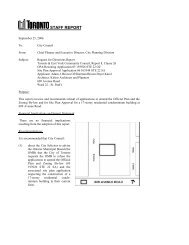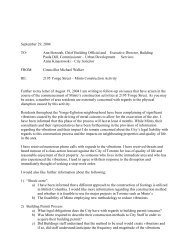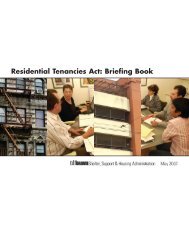Residential Tenancy Reform Consultation Paper
Residential Tenancy Reform Consultation Paper - Michael Walker
Residential Tenancy Reform Consultation Paper - Michael Walker
You also want an ePaper? Increase the reach of your titles
YUMPU automatically turns print PDFs into web optimized ePapers that Google loves.
Regional decontrol<br />
RESIDENTIAL TENANCY REFORM CONSULTATION PAPER<br />
To stimulate the production of new rental housing, and<br />
to encourage landlords to invest in the maintenance<br />
of existing rental stock, the government will explore ways<br />
to remove rent controls in regions with sustained high<br />
vacancy rates. This is known as “regional decontrol.”<br />
The government recognizes the importance of consulting<br />
on how this initiative could be implemented and has stated<br />
that, at a minimum, rent controls should not be lifted in a<br />
region unless there are sustained high vacancy rates of at<br />
least 3 per cent in all income categories. The government’s<br />
proposed goals for regional decontrol are to give developers<br />
an opportunity to “build their way out of rent controls”<br />
while ensuring that, in regions where it is necessary, both<br />
existing and new tenants are protected by full rent controls.<br />
Background:<br />
When consumers have many choices, suppliers must price<br />
their goods or services more competitively. This holds true<br />
in the rental market – when more rental units are available,<br />
landlords typically keep rent increases to below those<br />
permitted under rent controls and may forego increases or<br />
even reduce rents. High vacancy rates tend to have the<br />
same effect as rent controls in protecting tenants from<br />
excessive rent increases.<br />
Rent controls were first introduced in Ontario in 1975.<br />
Rent increases for most privately-owned rental units have<br />
been limited by rent controls since then. While exemptions<br />
from rent controls have existed for certain types of rental<br />
buildings, there have never been exemptions based on<br />
local vacancy rates. 2<br />
There are issues with existing vacancy rate data to consider<br />
before undertaking a major new initiative such as regional<br />
decontrol based on that data. Vacancy data compiled by<br />
Canada Mortgage and Housing Corporation (CMHC) are<br />
currently the most reliable and extensive, but there are<br />
limitations. CMHC reports on purpose-built rental units<br />
within buildings with three or more rental units; the secondary<br />
rental market is not counted. The secondary rental<br />
market includes a significant number of units: accessory<br />
apartments in family homes such as basement apartments,<br />
apartments over garages and stores, rented condominiums,<br />
and rented houses and duplexes. This part of the<br />
market helps meet demand for rental housing, providing<br />
up to 40 per cent or more of all rental units within some<br />
areas. The secondary rental market is also important<br />
because many of its units are the most affordable types of<br />
rental housing.<br />
As the government wants to ensure that vacancy rates in<br />
each segment of a local market — low, moderate and high<br />
end — are above at least a 3 per cent threshold before<br />
decontrolling a region, more analysis must be done in order<br />
to make a decision based on vacancy data that recognizes<br />
the secondary market. Unfortunately, it is very difficult to<br />
get information about the secondary market. The sector is<br />
informal and many units are not officially on the market.<br />
There are also a high number of illegal or unreported<br />
apartments in this sector.<br />
CMHC data is also limited because they do not include<br />
rental units in municipalities containing fewer than 10,000<br />
residents. This means that vacancy rates are not available<br />
for about one-third of Ontario’s 447 municipalities.<br />
The government could develop its own data sources and<br />
statistics. These could be used to develop a more comprehensive<br />
vacancy rate measure to implement regional<br />
decontrol. Although this may entail significant start-up<br />
and ongoing costs, the government would like to receive<br />
suggestions for how this information on the secondary<br />
market and smaller municipalities could be obtained. The<br />
government is interested in your input on how this data<br />
could be accurately collected. Another approach could be<br />
to research whether CMHC data could be extrapolated as<br />
a reasonably accurate reflection of the secondary market.<br />
2. At present, buildings built or first occupied since November 1991 are<br />
exempt from rent control.<br />
14






